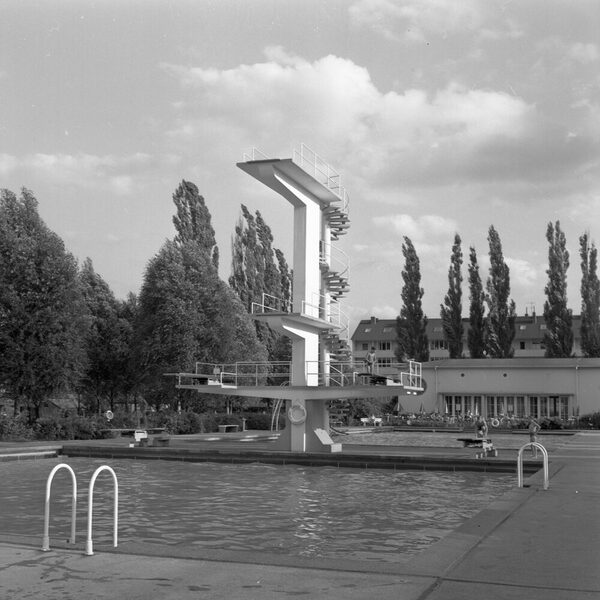Swimming pools
For a long time, Wiesbaden had no public bathing facilities apart from the Rhine. One exception was the cold-water spa in the Nero Valley. Wiesbaden's first public open-air swimming pool was opened here in 1854 with a pool measuring 30 × 12 meters. Boys could learn to swim in the water, which was only 13.6 °C cold. In the 1890s, the baths disappeared as part of the redesign of the Nerotal park. Since 1895, the indoor swimming pool of the Augusta-Victoria-Bad at the Hotel Kaiserhof, which could also be used by Wiesbaden residents and spa guests, offered a replacement. The Opelbad on the Neroberg, which opened in 1934, was the city's first actual outdoor swimming pool. Planning for the Kleinfeldchen outdoor pool began just five years later. A sports field had existed here since 1919, which was founded on the site of former allotment gardens on the initiative of local residents and had been managed by the Office for Physical Exercise since 1920.
In 1939, the town was granted a subsidy of 250,000 RM by the Ministry of the Interior for the construction of the so-called Kleinfeldchen public swimming pool. The plans were scuppered due to the war, but were resumed immediately after 1945. The construction costs amounted to DM 1 million. In mid-1951, the swimming pool designed by architect and head of the planning department of the building construction office Géza Lörincz, which was praised as one of the most modern pools in West Germany with its elegant 10-meter diving tower, was inaugurated. In 1964, the Kleinfeldchen swimming pool had 337,000 visitors. This meant that it had reached the limits of its capacity; an expansion of the sunbathing areas and the construction of an indoor swimming pool were announced. It was not until 1976 that the indoor pool with a 25-metre pool and a training hall for schools and clubs was inaugurated.
The need to provide the population with more pools had already been stated in the 1963 baths report. At that time, Wiesbaden's largest swimming pool, the Maaraue outdoor pool in Kostheim, had already been under construction for several years. It was opened on 09.07.1965 in the landscape conservation area between the Rhine and Main rivers. Another swimming pool, which was to be available to the districts of Biebrich and Schierstein with the residential areas of Gräselberg and Waldstraße, was opened on 16.06.1970 after two years of construction. It was planned by Wiesbaden architect Horst Nießen. The pool was named after Kalle AG, whose donation amounted to 1 million on the occasion of a company anniversary.
The plans for the construction of a new indoor swimming pool, which had existed since 1946 and were all the more urgent as the swimming pool in the Augusta Victoria Hotel had been destroyed during the war, were postponed for the time being for cost reasons. Swimmers only had a small pool in the rheumatism clinic as a substitute in winter. This changed with the inauguration of the new indoor pool on Mainzer Straße on 24.05.1954. A state-of-the-art indoor pool with 50-metre and 25-metre pools and a diving tower up to 7.50 m was built in a former Stadtwerke machine hall to designs by Horst Nießen. The indoor pool operated by Stadtwerke, which has been an ESWE pool since 1970, is now (2015) known as the "Mainzer Straße leisure pool" and is managed by "mattiaqua", the city's own company for springs, pools and leisure.
In addition to the Mainzer Straße leisure pool and the Aukammtal thermal pool built in 1976, there is another indoor pool in Kostheim, which was opened on 23.07.1976 after 19 months of construction.
Literature
Herzfeld, Gottfried: Freizeiteinrichtungen für Jugendförderung und Kulturpflege, Leibesübungen und Sport in der Stadtgemeinde Wiesbaden, Wiesbaden 1956.
mattiaqua (ed.): Annual report 2010 mattiaqua, Wiesbaden 2011; administrative reports.
Collection of newspaper clippings from the Wiesbaden City Archives, "Swimming pools".
